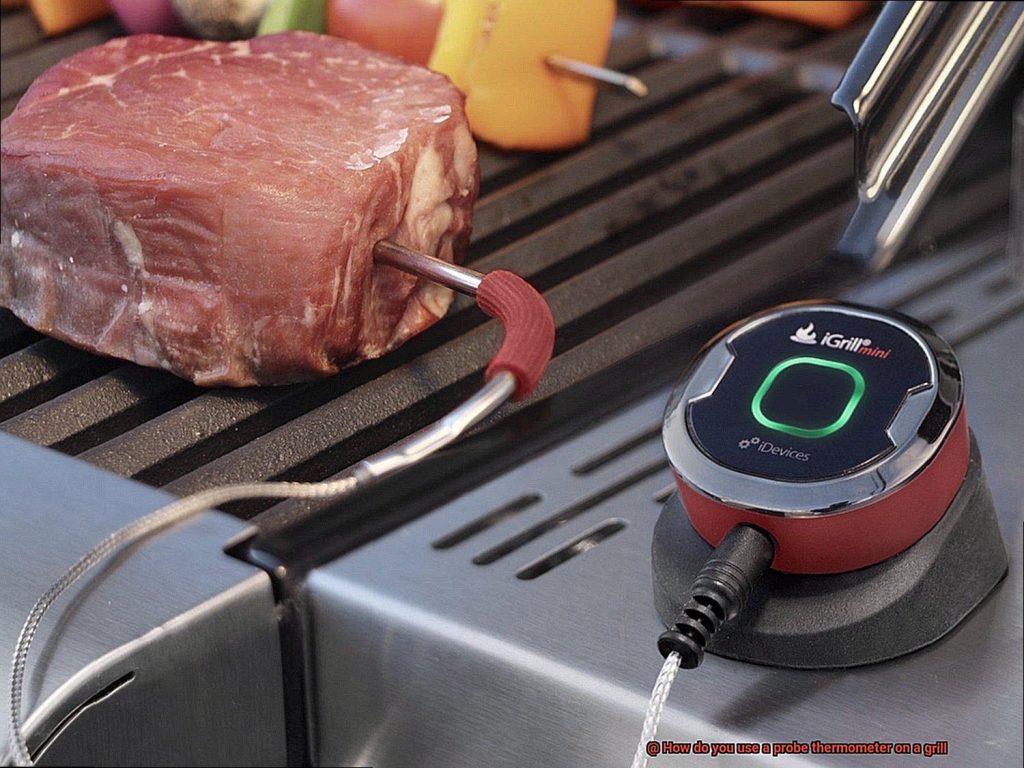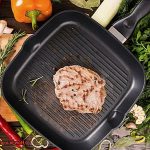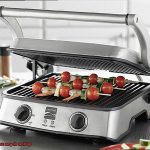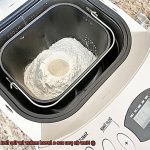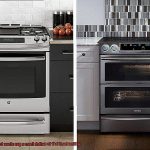It’s that time of year again – grilling season. There’s nothing quite like the taste of charred meat and veggies hot off the grill. But, did you know that grilling is also a science? And every grill master needs a trusty probe thermometer in their arsenal.
A probe thermometer is a digital thermometer with a long, thin probe that gives you an accurate temperature reading when inserted into meat. It takes out all the guesswork and ensures your meat is cooked to perfection.
Don’t worry if you’re new to using a probe thermometer – it’s actually pretty simple. The key is knowing where and how to place the probe for an accurate reading. With this knowledge, you can cook up the juiciest chicken or perfectly medium-rare steak.
In this blog post, we’ll cover everything from selecting the right type of thermometer (wired or wireless) to calibration tips for optimal accuracy. We’ll also share some common grilling mistakes to avoid so that you can achieve the best results every time.
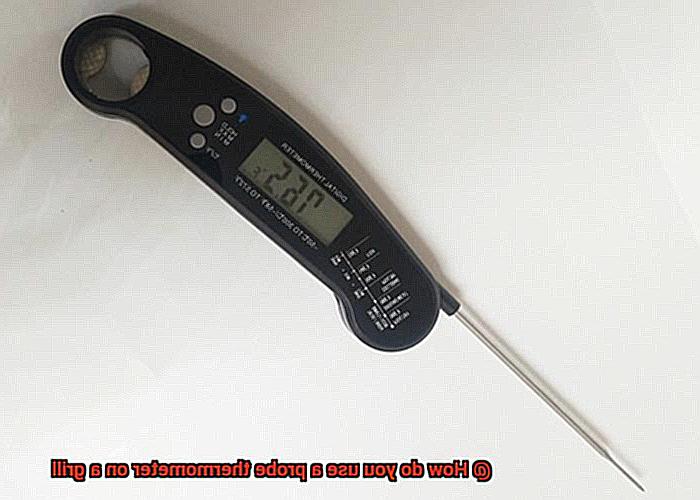
So get ready to become a grilling pro with our guide on how to use a probe thermometer on your grill. Let’s dive in.
Contents
What is a Probe Thermometer?
Look no further than a probe thermometer.
A probe thermometer is a kitchen tool that’s designed to measure the internal temperature of cooked meat or poultry. It comes equipped with a long metal probe made of durable stainless steel and a digital or analog display unit that shows the temperature reading.
There are two different types of probe thermometers: instant-read and leave-in. Instant-read thermometers give you a quick temperature reading within seconds, while leave-in thermometers are designed to be left inside the meat for the entire cooking process.
Using a probe thermometer on a grill can be an essential step towards achieving perfectly cooked meat. To get started, make sure you have a reliable probe thermometer that’s suitable for use on a grill. Next, insert the probe into the thickest part of the meat, being careful not to touch any bone or fat. This will give you an accurate reading of the internal temperature of the meat. Keep the probe in the meat throughout the cooking process and regularly check the temperature to ensure that it’s cooking evenly.
Different types of meat require different internal temperatures to be considered safe for consumption. For example, chicken should be cooked to an internal temperature of 165°F, while beef can be cooked to a lower temperature depending on your preference. It’s important to note that the location of the meat on the grill can affect its temperature. Therefore, move the probe around as needed to get an accurate reading.
Using a probe thermometer on a grill is easy and straightforward. With its accurate temperature readings and easy-to-use design, using a probe thermometer has never been easier. Here are some key benefits of using a probe thermometer:
- Ensures that your meat is cooked to perfection every time
- Helps prevent overcooking or undercooking
- Reduces the risk of foodborne illness by ensuring that meat is cooked to a safe internal temperature
- Saves time and effort by eliminating the need for guesswork
Choosing the Right Probe Thermometer for Grilling
As a grill master, you know that achieving perfectly cooked meat is the ultimate goal. One tool that can help you achieve this is a probe thermometer. However, with so many options on the market, choosing the right one can be overwhelming. Fear not – I have compiled some factors to consider when selecting the perfect probe thermometer for your grilling needs.
Firstly, take into account the type of meat you will be cooking. Different meats require different cooking levels, and a thermometer with multiple probes can be useful in monitoring the temperature of various meats simultaneously. This feature saves time and ensures that everything is cooked to perfection.
Secondly, accuracy is crucial. A difference of just a few degrees can make or break your meat’s tenderness and juiciness. Hence, it would be best to look for a thermometer with high accuracy and a quick response time so that you don’t have to worry about overcooking or undercooking your meat.
Thirdly, consider the temperature range of the thermometer. You want to make sure that it measures the desired temperature range for your specific grilling needs accurately. Some thermometers come with preset temperature settings for different types of meat, making it easier to achieve the perfect result.
Lastly, durability and ease of use are equally important. Your thermometer should be made from sturdy materials that can withstand high temperatures and frequent use. Furthermore, it should be easy to read and operate, even in low-light conditions.
Inserting the Probe into the Meat
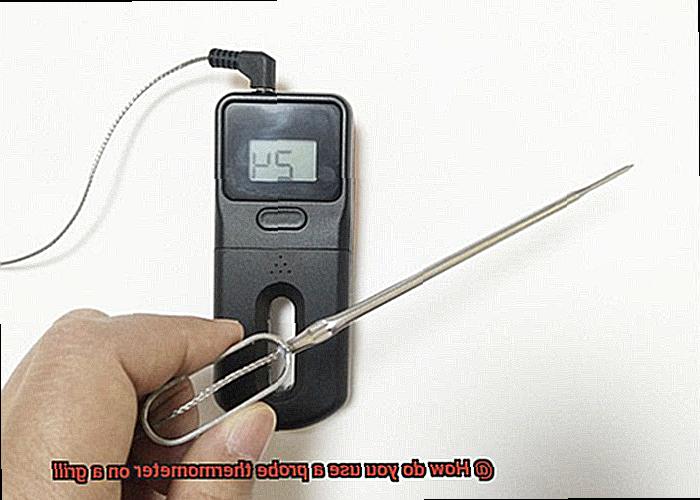
You’ve got the perfect probe thermometer, now let’s talk about the next crucial step in achieving perfectly cooked meats – inserting the probe into the meat. Here are some tips and techniques for a precise reading every time.
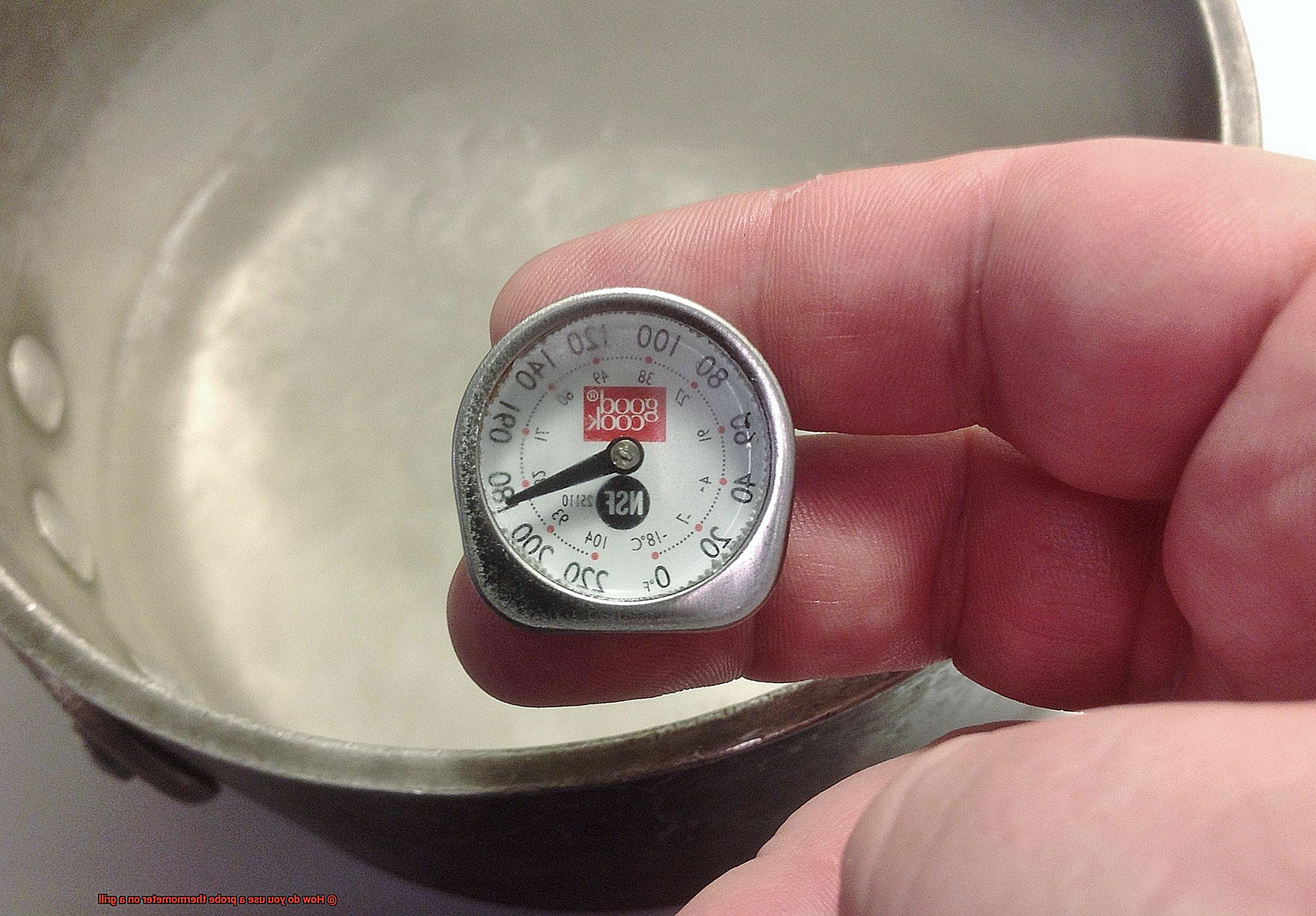
Firstly, consider the type of meat you’re cooking. For thicker cuts, insert the probe in the thickest part to get an accurate reading. For thinner cuts, aim for the center to ensure that the temperature reading is most accurate for the part that takes longest to cook.
When inserting the probe, remember to avoid hitting any bones as this can give an inaccurate reading. Instead, aim for a 45-degree angle to ensure that the thermometer goes deep enough into the meat without piercing through to the other side.
It’s crucial that the thermometer probe is fully inserted into the meat but not touching any bones or gristle. Touching these parts can cause an inaccurate reading and affect overall cooking time. So make sure to double-check before you start grilling.
Another important step is to clean and sanitize your probe before and after each use. This will prevent any bacteria from remaining on your thermometer and causing cross-contamination. A quick wash with warm soapy water or a sanitizing solution will do the trick.
So, here are some key takeaways for inserting the probe into your meat:
- Consider the type of meat you’re cooking and where to insert the probe
- Aim for a 45-degree angle to avoid hitting bones
- Make sure the probe is fully inserted but not touching bones or gristle
- Clean and sanitize your probe before and after each use
Monitoring the Internal Temperature of the Meat
Grilling is an art form, and there’s nothing like the smoky aroma of perfectly cooked meat wafting through the air. But getting that ideal level of doneness can be a daunting task, especially when cooking different types of meat. That’s where a probe thermometer comes in – it’s the key to monitoring the internal temperature of your meat and ensuring it’s cooked to perfection.
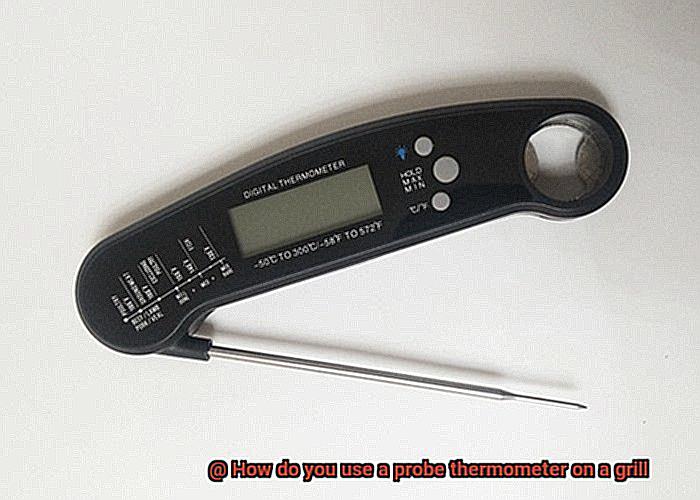
To use a probe thermometer, start by inserting the probe into the thickest part of the meat. Avoid bones and gristle, as they can throw off your reading. Aim for a 45-degree angle and make sure the tip of the probe is in the center of the thickest part of the meat.
Next, turn on your thermometer and wait for it to give you a reading. Some thermometers have an instant-read feature, while others take a few seconds to give you a reading. Either way, be patient – it’s better to wait a few extra seconds than risk undercooked or overcooked meat.
Different types of meat have varying safe internal temperatures that need to be reached before consumption. For instance, beef should be cooked to 145°F for medium-rare, 160°F for medium, and 170°F for well-done. Poultry should be cooked to 165°F, while pork should be cooked to 145°F.
It’s worth noting that leaving the thermometer in the meat while it’s cooking on the grill can cause damage to both the thermometer and the meat. Once you’ve taken your reading, remove the probe from the meat and clean it thoroughly before using it again.
So, using a probe thermometer is an easy and effective way to ensure that your grilled meats are cooked to perfection. Here are some key takeaways:
- Insert the probe into the thickest part of the meat
- Avoid bones and gristle
- Wait for your thermometer to give you a reading
- Different types of meat have different safe internal temperatures
- Don’t leave the thermometer in the meat while it’s cooking
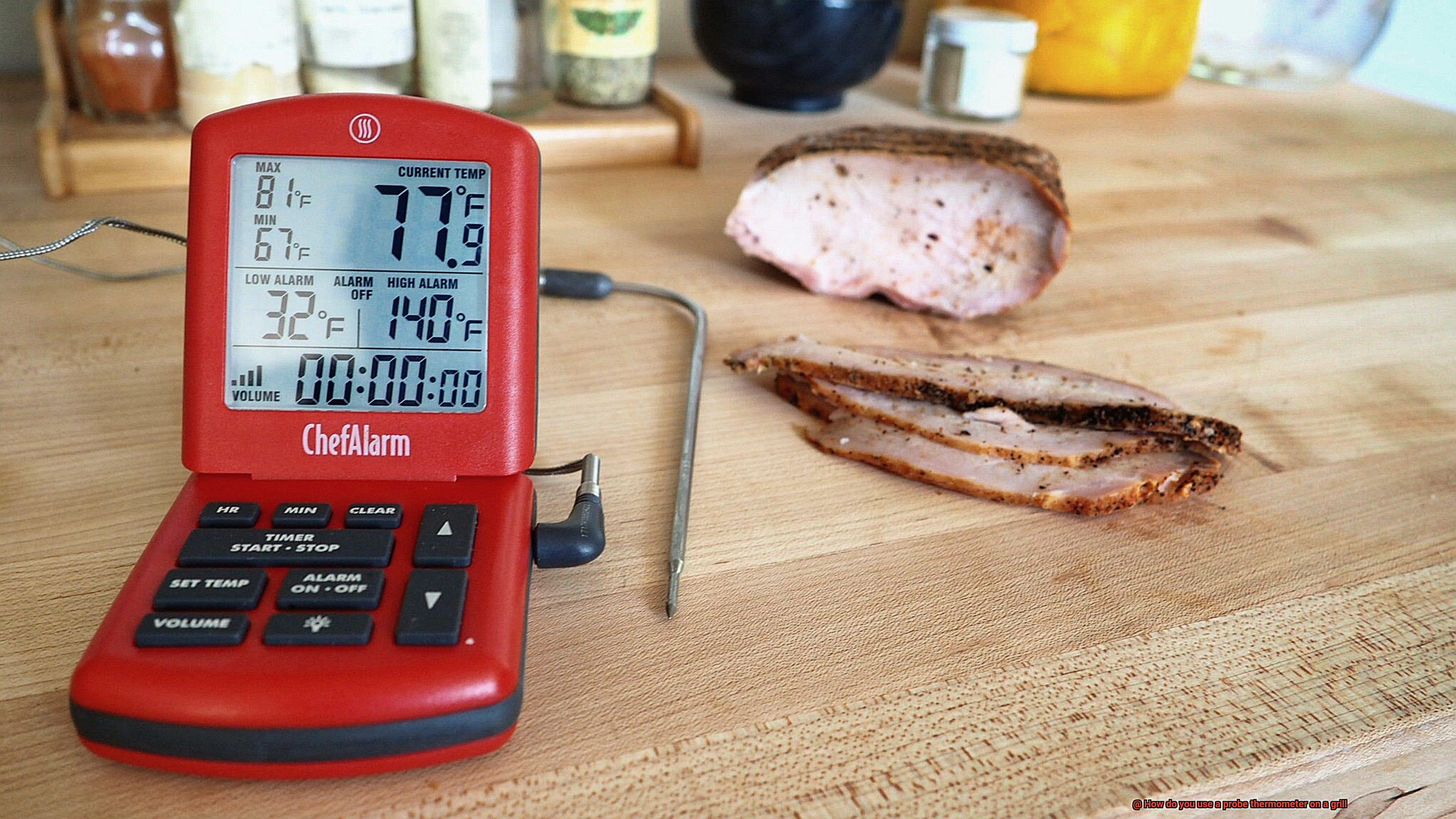
Different Types of Meat Require Different Internal Temperatures
Grilling meat is a delectable experience, but it’s also important to remember that different types of meat require different internal temperatures to be safe for consumption. To ensure perfectly cooked meat every time, it’s essential to use a probe thermometer on the grill. Here are five key aspects to consider when using a probe thermometer:
Appropriate Temperatures for Different Meats
Beef can be cooked to varying degrees of doneness, with rare being 125°F, medium-rare at 135°F, medium at 145°F, medium-well at 150°F, and well-done at 160°F. Pork should be cooked to an internal temperature of at least 145°F, while poultry should be cooked to a minimum internal temperature of 165°F.
Thickness of Meat
The thickness of the meat can affect its cooking time and internal temperature. Thicker cuts of meat will take longer to cook and may require a lower cooking temperature to avoid burning the outside while the inside remains undercooked.
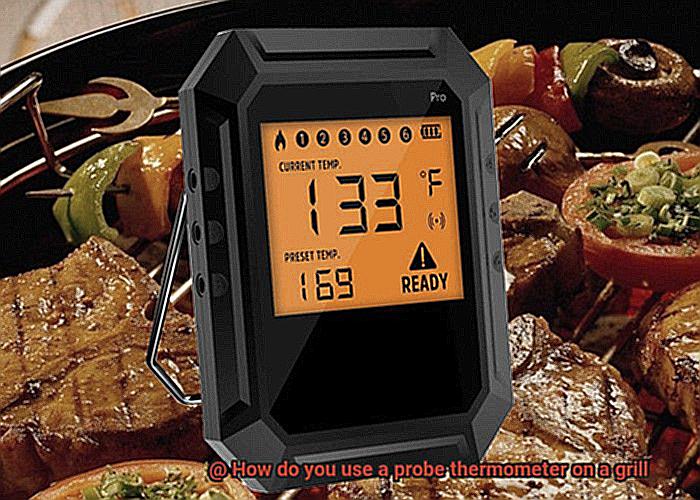
Correct Use of Probe Thermometer
A probe thermometer has a metal probe that is inserted into the thickest part of the meat to get an accurate reading. It’s crucial to avoid touching any bones or gristle when inserting the probe as this can give an inaccurate reading. Wait until the thermometer gives a stable reading before removing it from the meat.
Preheating the Grill
Before placing the meat on the grill, ensure it’s preheated to the appropriate temperature. This will help ensure the meat cooks evenly.
Sanitizing the Thermometer
After each use, it’s essential to clean and sanitize the thermometer thoroughly to prevent any cross-contamination.
The Location of the Meat on the Grill Matters
Grilling is more than just a cooking method; it’s an art form that requires precision and attention to detail. One of the most important factors to consider when grilling is the location of the meat on the grill. This is because different parts of the grill have varying temperatures that can affect how quickly or evenly the meat cooks. So, before you fire up the grill, let’s dive into why the location of the meat on the grill matters.
Let’s start with searing. Searing your meat over high heat directly above the flames is an excellent way to create a delicious crust on the outside while keeping the inside juicy and tender. However, after searing your meat, it’s time to move it to a cooler part of the grill to finish cooking more slowly and evenly. It’s crucial to place your probe thermometer in the thickest part of the meat to ensure that it reaches your desired level of doneness without overcooking or undercooking.
When it comes to poultry, there’s an added concern of foodborne illness. That’s why it’s crucial to cook chicken all the way through. However, cooking poultry too quickly over high heat can cause the outside to become dry and tough while the inside remains undercooked, which is not safe for consumption. To avoid this, start by searing your chicken over high heat and then move it to a cooler part of the grill to finish cooking through. And don’t forget to use your trusty probe thermometer. Make sure it reaches an internal temperature of 165°F (74°C), which is considered safe for consumption.
Here are some additional tips and sub-topics you should consider when grilling:
- Understanding how different parts of your grill affect cooking times and temperatures: The area closest to the flames will be hotter than other parts of the grill, so be mindful of where you place your meat accordingly.
- Using your probe thermometer effectively based on where your meat is positioned on the grill: Always place the thermometer in the thickest part of the meat to ensure that it’s cooked to perfection.
- Achieving perfectly cooked meat every time by paying attention to location and temperature: By understanding how different parts of the grill affect cooking times and using a probe thermometer correctly, you can consistently achieve perfectly cooked meat.
Practicing and Patience are Key to Perfectly Cooked Meats
Grilling is an art form that requires careful attention and skill, especially when it comes to cooking meats. If you want to achieve perfectly cooked meats, then using a probe thermometer is an essential tool in your arsenal. However, just having a thermometer is not enough. Practicing and patience are the keys to success.
Firstly, practicing with your thermometer is crucial. It’s important to get comfortable with using it and to develop a sense of what temperatures different types of meats should be cooked to. By testing the temperature of your meats as you cook them and comparing them to recommended cooking temperatures, you’ll be able to refine your grilling skills. With practice, you’ll become more confident in using your thermometer and will be able to rely on it to help you achieve perfectly cooked meats every time.
Secondly, patience is critical when it comes to grilling with a probe thermometer. It can be tempting to rush the cooking process and remove your meats from the grill too soon. However, this can result in undercooked or unevenly cooked meats. Instead, take the time to monitor the temperature of your meats and keep them on the grill until they reach the desired internal temperature. This may require adjusting the heat of your grill or moving your meats around to ensure even cooking, but the end result will be worth the effort.
In addition to practicing and patience, there are other factors that can help you achieve perfect results on the grill:
- Preheat your grill: Make sure your grill is preheated before adding your meats. This will ensure even cooking and help prevent sticking.
- Use high-quality meat: The quality of your meat matters when it comes to grilling. Invest in high-quality cuts for the best results.
- Let your meat rest: After removing your meat from the grill, let it rest for a few minutes before cutting into it. This allows the juices to redistribute throughout the meat, resulting in a juicier and more flavorful final product.
kNoaConaxC0″ >
Conclusion
Grilling is a culinary art that requires precision and expertise. A reliable probe thermometer is an indispensable tool for every grill master, enabling them to achieve perfectly cooked meat with ease. By taking the guesswork out of cooking temperatures, you can ensure your guests are served delicious and safe-to-eat food.
To use a probe thermometer on a grill, you must first choose the right type of thermometer – wired or wireless – based on your needs. Once selected, insert the probe into the thickest part of the meat without touching any bone or fat. Different types of meat require different internal temperatures for safe consumption; therefore, it’s essential to move the probe around as needed to get an accurate reading.
When choosing a probe thermometer for grilling, consider factors like accuracy, temperature range, durability, and ease of use. Inserting the probe into the meat requires careful consideration based on the type of meat you’re cooking. Aim for a 45-degree angle to avoid hitting bones while ensuring it’s fully inserted but not touching bones or gristle. Clean and sanitize your thermometer before and after each use.
The placement of your meat on the grill matters because different parts have varying temperatures that can affect how quickly or evenly it cooks. Practicing with your thermometer and exercising patience are vital when it comes to achieving perfectly cooked meats on a grill.

